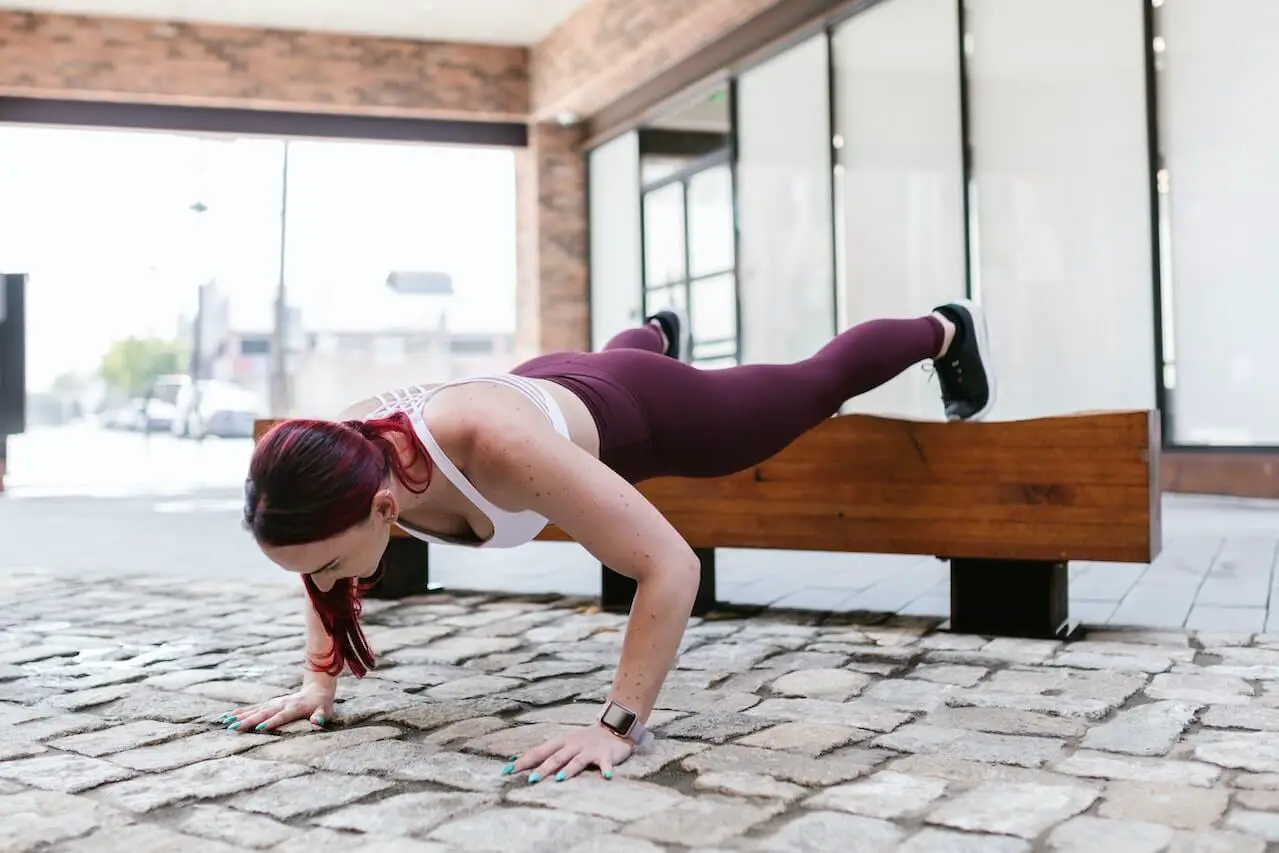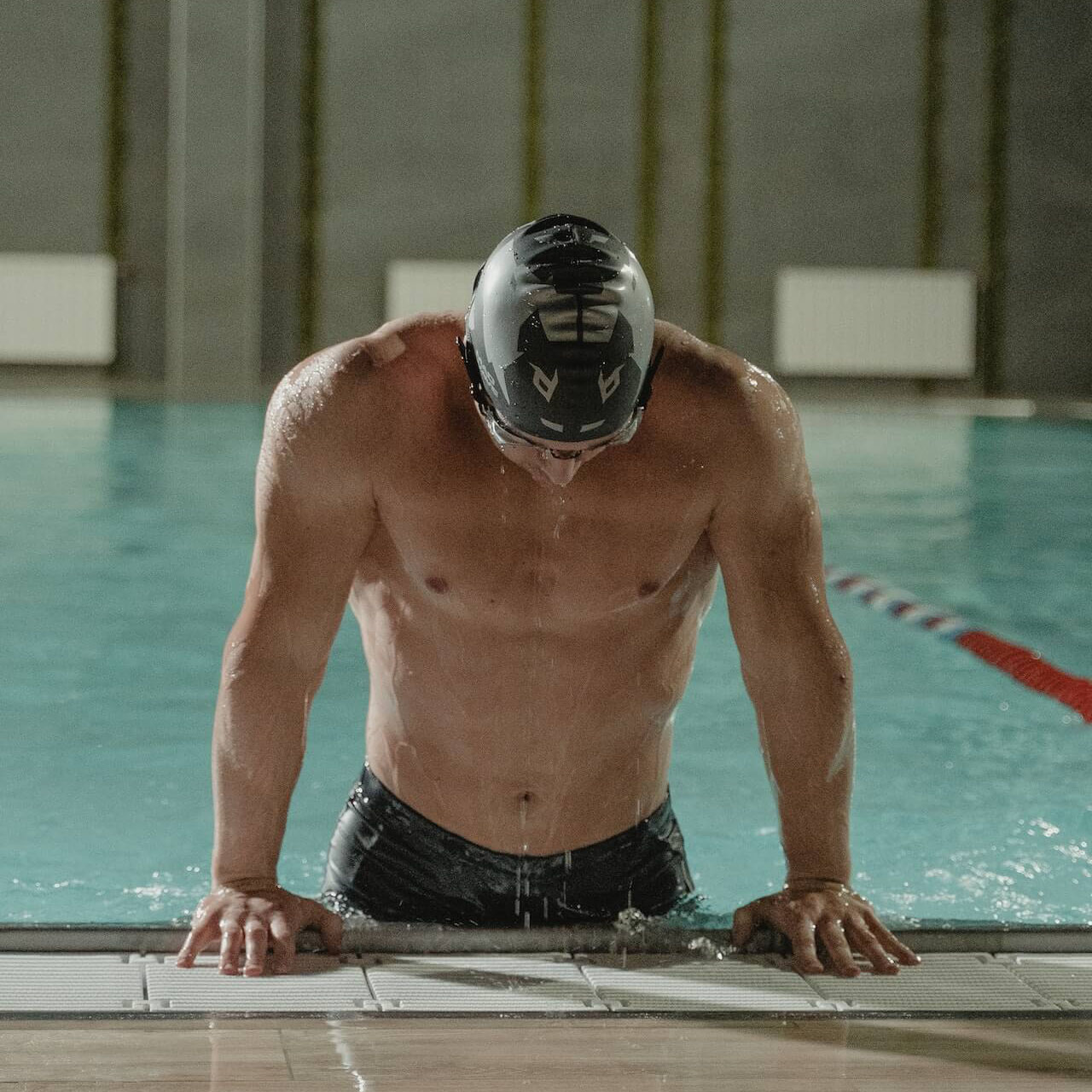Push-ups are a popular and versatile exercise for general fitness, but have you wondered if they’re good for swimmers?

Push-ups can help swimmers develop strong upper body muscles, such as your pecs, shoulders, triceps, and even lats, which are crucial for powering through the water. Incorporating this simple yet effective exercise (as well as its variations) into your dryland training can give you a competitive edge in the pool.
In this article, we’ll delve into the world of push-ups, their advantages for swimmers, and some variations to make them more swimming-specific.
The Importance of Push-Ups for Swimmers
Upper Body Strength and Endurance Benefits

Push-ups are a versatile exercise, and as a testament to that, you can incorporate it into your dryland training to improve your performance while swimming. Specifically, they help build upper body strength and endurance, which are crucial for a powerful stroke in the pool.
As you perform a proper push-up, you engage almost every muscle in your upper body including your chest, shoulders, triceps, and lats, which are key muscle groups involved in swimming.
What’s great about push-ups is that you can do them with just your bodyweight, or you can wear a backpack loaded up with books to do weighted push-ups. You don’t need access to a gym, and you can do them anytime and anywhere!
Core Strengthening
Another advantage of push-ups for swimmers is the core strengthening aspect. When done correctly, push-ups force you to engage your core muscles, including your abdominal and lower back muscles.
A stable and strong core is essential for maintaining proper body position, balance, and efficiency in the water.
As you are doing your push ups, remember to flex your core muscles to maintain stability, and this can translate to having a stable core while swimming as well.
Injury Prevention
Injury prevention is vital for swimmers like you, and push-ups can play a role in reducing the risk of shoulder injuries.
Performing push-ups with proper technique and alignment helps protect your shoulder joints by increasing their stability and strength.
Muscles Worked by Push-Ups
When you perform a push-up, you’re working various muscles in your shoulders, chest, back, and arms. Let’s discuss the specific muscles involved in this exercise and how they benefit your swimming.
Pectoralis Major (Chest)
The primary muscle groups engaged in push-ups include the pectoralis major (pectoral muscles), triceps, biceps, and deltoids (shoulder muscles). Your pectoralis major is responsible for horizontal arm movements, such as the push phase in freestyle swimming. Strengthening this muscle will help you generate more force through the water with each stroke.
Biceps and Triceps (Arms)
Your triceps and biceps play a significant role in arm extension and flexion. As you push up from the ground, your triceps are working to straighten your arm while your biceps provide stability and control. These muscles are important for a strong pull in all swimming strokes, as well as maintaining proper arm positioning and technique.
Deltoids (Shoulders)
Your shoulder muscles, primarily the deltoids, assist in stabilizing your arm and chest muscles during a push-up. This stabilization is crucial for swimmers, as the shoulders are heavily involved in each stroke’s mechanics and need a solid foundation of strength to prevent injury.
Abdominals and Obliques (Core)
In addition to your arms and chest, push-ups engage your core muscles, which include the abdominals, obliques, and lower back muscles. A strong core is essential for maintaining proper body alignment in the water, transferring power from your arms and legs during each stroke, and preventing injuries.
Latissimus Dorsi (Back)
Lastly, one of the most critical muscles that push-ups engage is your latissimus dorsi, also known as your lats. These are the broadest muscles in your back, stretching across your shoulders and down to your waist.
While doing push-ups, your lats work in conjunction with your shoulder and arm muscles to stabilize your movements and help you push off from the ground.
Your latissimus dorsi play a key role in each stroke, particularly in the pull phase. Whether you’re swimming freestyle, butterfly, backstroke, or breaststroke, your lats power the underwater portion of each stroke, helping to pull your body forward in the water.
Furthermore, strong lats can improve your streamline position in the water, which is crucial for efficient swimming and reducing drag.
Integrating Push-Ups into a Swimmer’s Training Routine
Ideal Push-up Form for Swimmers
To reap the maximum benefits from push-ups, it’s essential to maintain proper form. Here’s a step-by-step guide on the right push-up form for swimmers:
- Start in a plank position with your hands slightly wider than shoulder-width apart.
- Focus on maintaining a neutral head and spine position, mimicking your head position in the water.
- Keep your core engaged and lower your body until your chest nearly touches the ground.
- Push back up to the starting position and repeat.
Be sure to avoid common mistakes, such as arching your back, flaring your elbows, or not going low enough.
Types of Push-ups Beneficial for Swimmers
There are several push-up variations that can specifically target muscles used in swimming, including:
- Traditional push-ups: These target your pectoral and triceps muscles, which are crucial for various swimming strokes.
- Decline push-ups: By elevating your feet on a bench or step, you can emphasize the upper pectoral muscles, helping with the initial catch phase in freestyle and butterfly strokes.
- Wide-grip push-ups: With your hands wider apart, this variation focuses on your chest and shoulder muscles, improving your overall upper-body strength for all swimming strokes.
- Close-grip push ups: The closer your hands are when doing a push-up, the more emphasis it places on your triceps muscles which is really good for bringing up lagging triceps.
How and When to Incorporate Push-ups in the Training Routine
To effectively integrate push-ups into your swim training, consider the following recommendations:
- Aim for 2-3 sessions per week, with 4-5 sets of 10-15 reps, depending on your fitness level.
- Progressively increase intensity by adding more reps or sets, or by switching to more challenging variations like decline push-ups.
- For enhanced swimming-specific benefits, combine push-up sessions with swim training by completing a set of push-ups, followed by a short, fast swim (15-25 meters) to help your muscles adapt.
Preventing Injuries and Improving Technique
Avoiding Common Mistakes
When doing push-ups, be mindful of your posture to avoid common mistakes that could hinder your progress or cause injuries. Key points to consider are:
- Keep your head aligned with your spine; avoid looking forward or tucking your chin.
- Maintain a tight core to prevent your hips from sagging or hiking.
- Don’t flare your elbows out to the sides, as this puts more strain on the shoulder joint.
- Ensure both hands are evenly distributing your weight.
Mitigating Risk of Injury
While push-ups are an excellent exercise for swimmers, take precautions to minimize your risk of injury.
Be attentive to your body and avoid overexertion – if you experience pain during push-ups, stop immediately to prevent further damage. Work on shoulder stabilization exercises such as shoulder shrugs, scapular push-ups, and wall slides to develop strong foundation muscles.
Integrating other variations of push-ups, such as incline, decline, or close-grip push-ups, can also help to distribute the load on your shoulders, reducing the risk of injury. Remember to always warm up properly before starting your push-up routine.
Incorporating proper push-up techniques, avoiding common mistakes, and taking precautions to mitigate the risk of injury will help you enhance your swimming performance and ultimately prevent shoulder injuries. Stay consistent with your exercises and continually develop your technique for the best results.
Sources:
- https://prorehab.com/blog/is-the-push-up-good-for-swimmers/
- https://www.healthline.com/health/fitness-exercise/muscles-worked-push-ups
- https://www.swimmingworldmagazine.com/news/push-up-progression-guide/
- https://www.upmc.com/Services/sports-medicine/for-athletes/swimming
- https://www.orthoinfo.org/en/staying-healthy/swimming-injury-prevention

